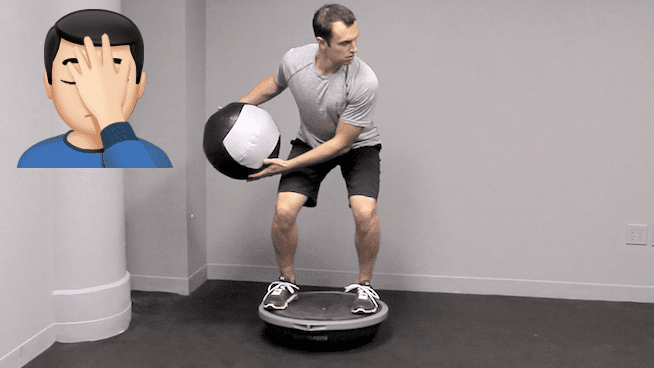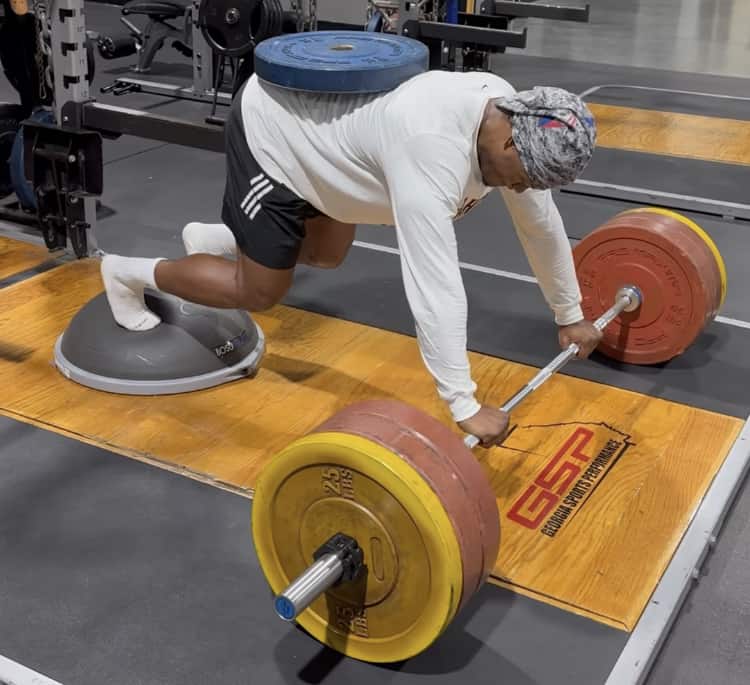
Step into any gym and you will likely see a rubber, half-moon-looking piece of workout equipment filled with air. This is called a Bosu ball.
The Bosu ball is rather ubiquitous in fitness centers. Even the worst hotel gym may have one lying around, looking pathetic and deflated over in the corner.
To its credit, the Bosu ball has become a popular piece of workout equipment in recent years, often used by fitness enthusiasts and trainers alike.
While the Bosu ball may seem like a great addition to any workout routine, as a strength and conditioning specialist, I’ve come to realize that it’s not as effective as it’s often portrayed. In fact, I believe that the Bosu ball is one of the dumbest pieces of workout equipment available.
Bear in mind this is coming from someone who has used a Bosu ball in the past, both for myself and with clients. Hey, it looks cool when you can balance on the thing.
Stability is a great thing to train and it’s important for a variety of reasons. But there is a right and a wrong way to do so.
Flaws of the Bosu Ball
Despite its popularity, the Bosu ball has a number of flaws that make it less effective than other pieces of workout equipment. Here are some of the most significant issues with the Bosu ball:
Difficult to Generate Maximum Force
One of the biggest issues with the Bosu ball is that it’s difficult to generate maximum force while standing on an unstable surface. When the body is forced to constantly adjust to maintain balance, it becomes more challenging to generate force, which is a necessity for building strength and muscle.
Exercises that require maximum force, such as squats and hip thrusts, are much less effective when performed on a Bosu ball. An easy way to combat this is to utilize a stable surface. A common stable surface that every gym and home has is known as the floor.
The argument some people make for unstable Bosu ball training is that it utilizes your stabilizer muscles more. While stabilizer muscles are activated during this type of training, they are not stimulated to the degree necessary for growth and development.
So now you’re in a scenario where your primary muscles are capped in their force production, and your stabilizer muscles, while activated, do not reach the threshold necessary for development. It’s a lose-lose situation.
Does Not Necessarily Improve Balance
What if I told you that the balancing act of standing on a Bosu ball does not improve balance at all?
Despite its reputation as a tool for balance, the Bosu ball does not necessarily do so in a way that translates to other activities. Balance is specific to the activity being performed, which means that standing on an unstable surface may not necessarily improve balance in other activities.
This is a concept many strength coaches simply cannot comprehend (cough Joel Seedman cough). You do not play football on a Bosu ball. You do not play basketball on a Bosu ball. You play them on flat surfaces; thus they should be practiced on flat surfaces.

To improve balance, it’s important to perform specific, targeted exercises that challenge balance in a way that is relevant to the activity being performed. For example, single-leg exercises, such as lunges and step-ups, are more effective for improving balance than standing on a Bosu ball.
Specificity is important. Even if you don’t play a sport, you should choose exercises relevant to your goal. If you want to become better at squats, do more conventional squats. The further you stray from the target, the more you are wasting your time.
Other Potential Flaws
In addition to these issues, there are other potential flaws with the Bosu ball that are worth considering. For example, using the Bosu ball can increase the risk of injury, especially for beginners or those with limited experience. Even an experienced athlete can tell you how weird it is standing on one for the first time.
The ironic thing is that improving stability is a great way to reduce injury risk. The only problem is that a Bosu ball won’t do much to help that.
When I didn’t know any better and was looking at equipment for my personal practice, I was stunned to see how expensive Bosu balls were. It’s no wonder gyms never replace them when they get old, as they can cost well over $100. When you consider the limitations of this piece of equipment, you’ll soon realize your money is best spent elsewhere.
Alternatives to the Bosu Ball
If you’ve been an advocate for Bosu ball training and are rethinking your stance, fear not. There are a number of alternatives for Bosu ball exercises.
As mentioned, the floor is an excellent start. Any exercise that can be performed on the Bosu ball can be performed on the ground.
If your goal is to improve balance, the easiest option is to use single-leg exercises. Unilateral movements should be a part of any routine regardless. Without realizing it, we may be favoring one side on a motion like a squat or a bench press. Over time this can lead to an imbalance (although it will likely be small all things considered). Incorporating single limb movements can mitigate the potential of a muscle imbalance.
Split squats, pistol squats, and single-leg Romanian deadlifts are far better options than hopping on a Bosu ball and shaking like a leaf.
Conclusion
It’s rare that you’ll find me saying anything related to diet or exercise is unequivocally bad. When it comes to the Bosu ball, it’s unlikely that anything you’re doing on there is downright harmful (provided you aren’t loading up the bar and performing squats).
However, time in the gym is precious. We have but so much to put into each workout. It’s important to get the most out of each session. At a certain point, workouts become so long that they just result in junk volume leading to more muscle damage than actual growth.
With that said it’s important to choose exercises carefully when programming. If you want to place a greater emphasis on stability, simply choose more free weight exercises on fixed surfaces like the ground or a bench. You could do more core work if you feel that is a limiting factor.
At the end of the day, a Bosu ball provides one thing: getting good at standing on a Bosu ball.
Recent Posts
Resistance bands can be part of an exercise routine for a variety of reasons. They serve many different functions and are one of the most inexpensive pieces of fitness equipment you could buy. Some...
Any athlete at the high school, college, or professional level will likely participate in some sort of strength and conditioning program. While that program is designed to improve athletic...
